Slabbing Comics - CGC Census Retrospective - Five Years at a Time
In last month’s article, the first CGC Census (July 2001) and the first 100,000 CGC-graded comic books were profiled. The books in the first “Top 10” for CGC submissions spanned 37 years – from 1963 to 2000, led by Spawn #1.
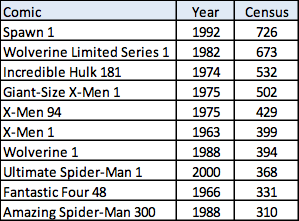 |
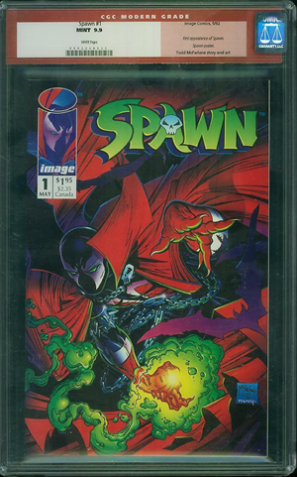 |
This month’s article steps through time in five-year blocks, looking at the CGC Census for books graded during 2000-2005, 2006-2010, 2011-2015, and 2016-2020. The Top 25 for each of the five-year timeframes do have many of the same books, however, these are separate lists isolating the books graded by CGC during those five-year spans and not a running total since CGC began. The Top 25 for the whole timespan from 2000-2020 is presented at the end of this article.
Starting with the Top 25 CGC Submissions for 2000-2005, the results for the first five years (technically a little over six years, from late 1999 until the end of 2005) have Wolverine Limited Series #1 as the most submitted book to CGC in the timeframe.
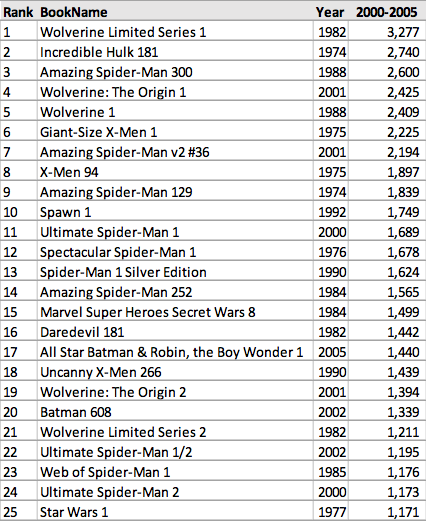 |
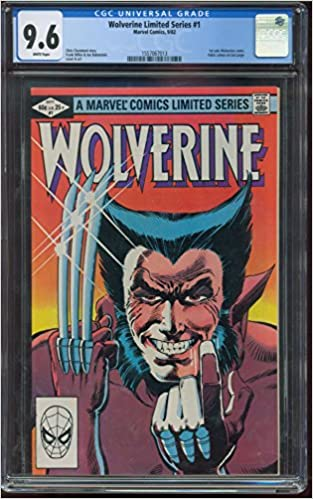 |
Contrasting with the first CGC census (July 2001), the submissions for Spawn #1 had dropped into 10th place for 2000-2005. Wolverine Limited Series #1 and Incredible Hulk #181 – which were 2nd and 3rd in 2001 – remained at the top of the list for submissions from 2000-2005. Spawn #1 is also the only book in the 2000-2005 Top 10 list which is not a Marvel publication. No books dated prior to 1974 were in the Top 25 submissions list for 2000-2005, when two were among the Top 10 in the July 2001 CGC Census (X-Men #1, Fantastic Four #48). Eight books in the Top 25 were printed since CGC began grading comics (January 2000), and the only two books from D.C. Comics in the Top 25 were printed in 2002 and 2005.
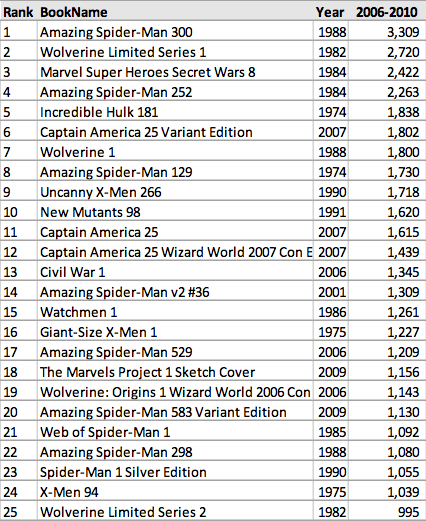 |
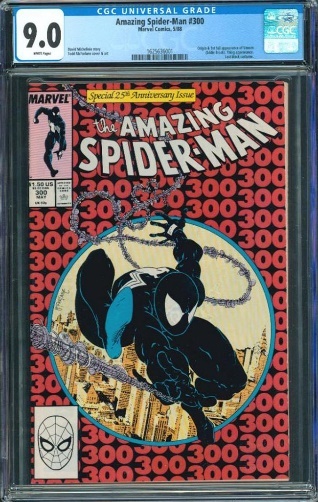 |
In the 2006-2010 timeframe, Amazing Spider-Man #300 moved ahead of both Wolverine Limited Series #1 and Incredible Hulk #181 to take the top position. Note that this is a list of the Top 25 submitted to CGC between 2006 and 2010, excluding any submissions already on the CGC Census from 2000-2005. Spawn #1 is no longer a Top 25 book during 2006-2010, and the only book in the Top 25 that is not a Marvel publication was Watchmen #1 (D.C. Comics, 1986). The Watchmen cinematic release occurred during 2009.
The previous 2000-2005 Top 25 list included 8 books printed between 2000-2005, and the 2006-2010 Top 25 list again includes eight books printed during the specified five-year timeframe. Amazing Spider-Man v2 #36 is the only book printed since CGC began which made both the 2000-2005 and 2006-2010 Top 25 lists. The other 7 books printed between 2000-2005 from the Top 25 for 2000-2005 were no longer among the top submissions during 2006-2010.
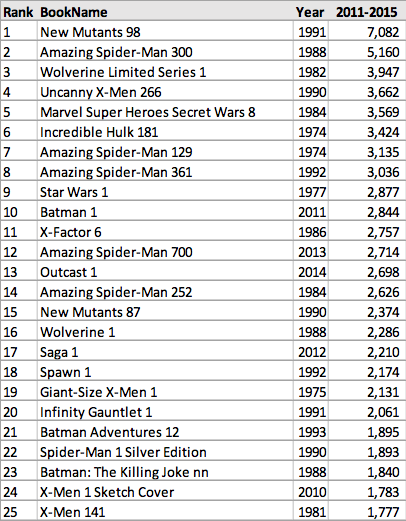 |
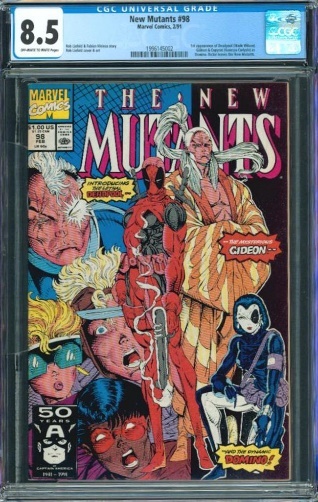 |
For the grading timeframe 2011-2015, New Mutants #98 moved into the 1st position, having been 10th during 2006-2010. Amazing Spider-Man #300 dropped to the 2nd position, but the number of submissions for ASM #300 increased from 3,309 from 2006-2010 to 5,160 for 2011-2015. The minimum number of submissions required to make the 25th position of the Top 25 list in this five-year timeframe was 1,777, which is more than 600 submissions higher than the 25th position in either of the previous Top 25 lists.
Only four books printed between 2011-2015 made this Top 25 list, after eight had done so in each of the prior lists. The only book printed between 2000-2010 on the 2011-2015 Top 25 was X-Men #1 Sketch Cover from 2010, which would have had a large number graded when it was relatively new during 2011.
Spawn #1 returned to the Top 25, while both Outcast #1 (2014) and Saga #1 (2012) also made the list as Image Comics publications. D.C. Comics is represented by Batman #1 (2011), Batman Adventures #12 (1993), and Batman: The Killing Joke (1988).
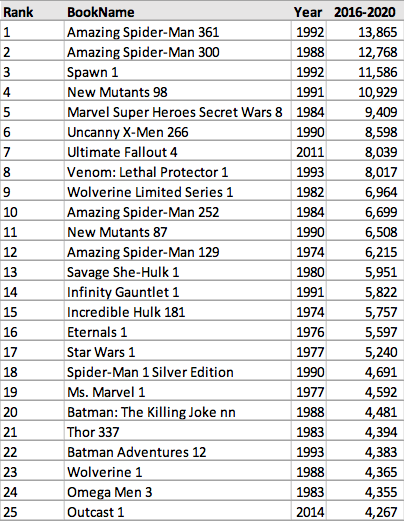 |
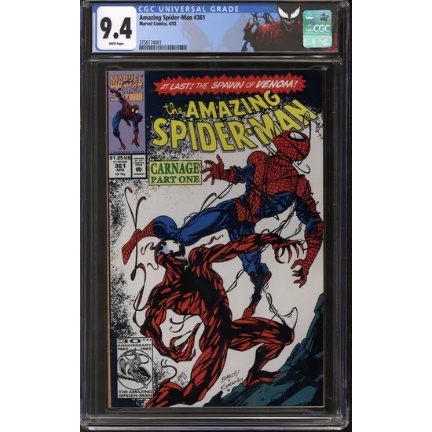 |
The Top 25 list for 2016-2020 has the fourth book to reach 1st position with Amazing Spider-Man #361, resulting in a new #1 in each of the Top 25 five-year lists. Amazing Spider-Man #300 moves to 2nd position and has not been lower than 3rd position in any of the lists. The 2016-2020 Top 25 is the first five-year list which has not had Wolverine Limited Series #1 (1982) in the top three positions. Wolverine LS #1 is in 9th position for the timeframe.
The 2016-2020 Top 25 list is the first to have no books printed during the five-year timeframe. CGC is still a popular choice for newly-released comic books, but the presence of eight contemporary books in both the 2000-2005 and 2006-2010 Top 25 lists has declined to zero for 2016-2020. Only two books printed during the twenty-year history of CGC are on the 2016-2020 Top 25, Ultimate Fallout #4 (2011) jumping up to #7 and Outcast #1 (2014), which is in danger of falling off the next Top 25 list at 25th position.
The 25th position for 2016-2020 had 4,267 submissions during the five-year timeframe, nearly 2,500 higher than the 25th position for 2011-2015. The 4,267 submissions for the 25th position in 2016-2020 is higher than every Top 25 book for each of the three prior five-year timeframes, except for the top two books in 2011-2015.

As mentioned in prior analysis articles, Amazing Spider-Man #300 is the most submitted book overall in CGC history, and it has been in the 1st position in every CGC Census total provided since December 31, 2012. The oldest books in each of the five-year Top 25 lists are from 1974, Incredible Hulk #181 and Amazing Spider-Man #129, neither of which ever dropped below 12th position. Overall, Fantastic Four #48 from 1966 is the oldest book to make the Top 25 list for 2000-2020, though it did not rank in the Top 25 for any of the five-year lists. Fantastic Four #48 was in positions 29, 49, 48, and 38 for 2000-2005, 2006-2010, 2011-2015, and 2016-2020, respectively. That stable ranking in the Top 50 each time propelled Fantastic Four #48 to 24th position overall.
In the next article from this series, the Top 25 books submitted to CGC from each decade will be examined, allowing books like Superman #1 (1939) and Amazing Fantasy #15 (1962) to be seen in the Top 25 of their decades (1930s and 1960s), and many other famous issues which simply do not have the overall CGC Census totals necessary for the Top 25 lists in this article.
About the Author
 |
Greg Holland has collected comic books for over 30 years and has been the administrator of the CGC Census Analysis website since 2003, currently located at CGCdata.com. He is the 1999 founder of the ValiantComics.com website and the 2004 ValiantFans.com message board. Dr. Holland holds a Ph.D. in information quality from the University of Arkansas at Little Rock and has held data science positions as research director, analyst, and administrator for government, corporations, and university. Active on the CGC Forums as ‘valiantman’ since 2002, he is also a 15+ year advisor to the Overstreet Comic Book Price Guide and contributor to later editions of the Standard Catalog of Comic Books. Greg resides in Arkansas, USA, with his wife of 23 years and their daughter. |
Related news
24 Oct 2022
Canadian Price Variants (CPVs) and GPAnalysis.com Recorded Sales
With Canadian Price Variants recorded in GPAnalysis.com for decades, what can the data tell us about rarity and value when comparing against direct editions?
Read more26 May 2022
CGC Census - A Game for the Thousandth Collector
Imagine a game where 1,000 lucky comic collectors are awarded the best available copies of comic books from the CGC Census. Where would ticket #1,000 be for the earliest appearances of favorite characters? Some winning books may surprise you.
Read more